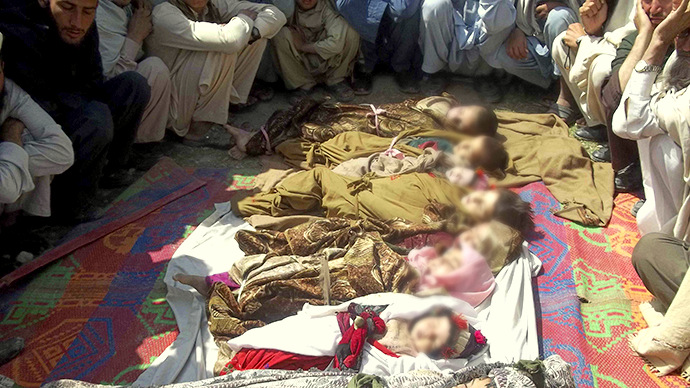4 Million Muslims Killed In Western Wars (Up to 2015 alone): Should We Call It Genocide?
MILITARISM, 3 Apr 2017
Kit O'Connell – MintPress News
Hearkening back to the Japanese interment camps of WWII, some Americans are now calling for Muslims to be placed in camps or even openly calling for genocide against the 1.6 billion practitioners of the faith.

Afghan villagers sit near the bodies of children who they said were killed during a NATO air strike in the Kunar province of Afghanistan. April 7, 2013. (Reuters)
18 Aug 2015 — It may never be possible to know the true death toll of the modern Western wars on the Middle East, but that figure could be 4 million or higher. Since the vast majority of those killed were of Arab descent, and mostly Muslim, when would it be fair to accuse the United States and its allies of genocide?
A March report by Physicians for Social Responsibility calculates the body count of the Iraq War at around 1.3 million, and possibly as many as 2 million. However, the numbers of those killed in Middle Eastern wars could be much higher. In April, investigative journalist Nafeez Ahmed argued that the actual death toll could reach as high as 4 million if one includes not just those killed in the wars in Iraq and Afghanistan, but also the victims of the sanctions against Iraq, which left about 1.7 million more dead, half of them children, according to figures from the United Nations.
Raphael Lemkin and the definition of genocide
The term “genocide” did not exist prior to 1943, when it was coined by a Polish-Jewish lawyer named Raphael Lemkin. Lemkin created the word by combining the Greek root “geno,” which means people or tribe, with “-cide,” derived from the Latin word for killing.
httpv://www.youtube.com/watch?v=moByGLA7FDc
The Nuremberg trials, in which top Nazi officials were prosecuted for crimes against humanity, began in 1945 and were based around Lemkin’s idea of genocide. By the following year, it was becoming international law, according to United to End Genocide:
“In 1946, the United Nations General Assembly adopted a resolution that ‘affirmed’ that genocide was a crime under international law, but did not provide a legal definition of the crime.”
With support from representatives of the U.S., Lemkin presented the first draft of the Convention on the Prevention and Punishment of Genocide to the United Nations. The General Assembly adopted the convention in 1948, although it would take three more years for enough countries to sign the convention, allowing it to be ratified.
According to this convention, genocide is defined as:
“…any of the following acts committed with intent to destroy, in whole or in part, a national, ethnical, racial or religious group, such as:
- Killing members of the group;
- Causing serious bodily or mental harm to members of the group;
- Deliberately inflicting on the group conditions of life calculated to bring about its physical destruction in whole or in part;
- Imposing measures intended to prevent births within the group;
- Forcibly transferring children of the group to another group.”
Under the convention, genocide is not merely defined as a deliberate act of killing, but can include a broad range of other harmful activities:
“Deliberately inflicting conditions of life calculated to destroy a group includes the deliberate deprivation of resources needed for the group’s physical survival, such as clean water, food, clothing, shelter or medical services. Deprivation of the means to sustain life can be imposed through confiscation of harvests, blockade of foodstuffs, detention in camps, forcible relocation or expulsion into deserts.”
It can also include forced sterilization, forced abortion, prevention of marriage or the transfer of children out of their families. In 2008, the U.N. expanded the definition to acknowledge that “rape and other forms of sexual violence can constitute war crimes, crimes against humanity or a constitutive act with respect to genocide.”
A Middle Eastern genocide
A key phrase in the convention on genocide is “acts committed with intent to destroy.” While the facts back up a massive death toll in Arab and Muslim lives, it might be more difficult to argue that the actions were carried out with the deliberate intent to destroy “a national, ethnic, racial or religious group.”
The authors of the convention were aware, however, that few of those who commit genocide are so bold as to put their policies in writing as brazenly as the Nazis did. Yet, as Genocide Watch noted in 2002: “Intent can be proven directly from statements or orders. But more often, it must be inferred from a systematic pattern of coordinated acts.”
In the aftermath of the 9/11 attacks, President George W. Bush employed a curious and controversial choice of words in one of his first speeches. He alarmed some by referencing historic, religious conflicts, as The Wall Street Journal staff writers Peter Waldman and Hugh Pope noted:
“President Bush vowed … to ‘rid the world of evil-doers,’ then cautioned: ‘This crusade, this war on terrorism, is going to take a while.’
Crusade? In strict usage, the word describes the Christian military expeditions a millennium ago to capture the Holy Land from Muslims. But in much of the Islamic world, where history and religion suffuse daily life in ways unfathomable to most Americans, it is shorthand for something else: a cultural and economic Western invasion that, Muslims fear, could subjugate them and desecrate Islam.”
In the wars that followed in Iraq and Afghanistan, the U.S. not only killed millions, but systematically destroyed the infrastructure necessary for healthy, prosperous life in those countries, then used rebuilding efforts as opportunities for profit, rather than to benefit the occupied populations. To further add to the genocidal pattern of behavior, there is ample evidence of torture and persistent rumors of sexual assault from the aftermath of Iraq’s fall. It appears likely the U.S. has contributed to further destabilization and death in the region by supporting the rise of the self-declared Islamic State of Iraq and Syria by arming rebel groups on all sides of the conflict.
After 9/11, the U.S. declared a global “War on Terror,” ensuring an endless cycle of destabilization and wars in the Middle East in the process. The vast majority of the victims of these wars, and of ISIS, are Muslims. And, as extremist terrorists created by the unrest increase tensions with their attacks on the West, some Americans are embracing Bush’s controversial language of religious warfare, calling for Muslims to be placed in camps or even openly calling for genocide.
__________________________________
 A gonzo journalist from Austin, Texas and Staff Writer for MintPress News, Kit O’Connell’s writing has also appeared at Truthout, the Texas Observer, and The Establishment.
A gonzo journalist from Austin, Texas and Staff Writer for MintPress News, Kit O’Connell’s writing has also appeared at Truthout, the Texas Observer, and The Establishment.
Go to Original – mintpressnews.com
DISCLAIMER: The statements, views and opinions expressed in pieces republished here are solely those of the authors and do not necessarily represent those of TMS. In accordance with title 17 U.S.C. section 107, this material is distributed without profit to those who have expressed a prior interest in receiving the included information for research and educational purposes. TMS has no affiliation whatsoever with the originator of this article nor is TMS endorsed or sponsored by the originator. “GO TO ORIGINAL” links are provided as a convenience to our readers and allow for verification of authenticity. However, as originating pages are often updated by their originating host sites, the versions posted may not match the versions our readers view when clicking the “GO TO ORIGINAL” links. This site contains copyrighted material the use of which has not always been specifically authorized by the copyright owner. We are making such material available in our efforts to advance understanding of environmental, political, human rights, economic, democracy, scientific, and social justice issues, etc. We believe this constitutes a ‘fair use’ of any such copyrighted material as provided for in section 107 of the US Copyright Law. In accordance with Title 17 U.S.C. Section 107, the material on this site is distributed without profit to those who have expressed a prior interest in receiving the included information for research and educational purposes. For more information go to: http://www.law.cornell.edu/uscode/17/107.shtml. If you wish to use copyrighted material from this site for purposes of your own that go beyond ‘fair use’, you must obtain permission from the copyright owner.